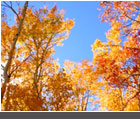The
program Seasons can be used in projection mode. It is recommended
that a student or small groups of students be allowed to
experiment with the software to run a variety
of “what if” experiments. The software interface
is easy to grasp, with very little teacher instruction necessary.
The software allows exploration of the effect of tilt and
orbit shape on the seasons. Here are some questions that
students can try to answer with the Seasons software. The
software, as purchased from Riverside, comes with an excellent,
well-illustrated teacher’s guide. Some situations the
students might want to look at (abbreviated from the Riverside
teacher’s guide):
Select the latitudes 45° N and 90° N
1. How can you explain why the Daily Solar Energy
curve for 90° N is nearly the same as at 45° N curve
in summer?
In July, the Daily Solar Energy at the pole is nearly the
same as at 45° N. This is because of the long days (24
hours of continuous daylight every day).
2. How many sunrises will you have at 90° N?
How did you find this?
One sunrise and one sunset. The Hours of Daylight curve shows
that each day either has 24 hours of daylight or 24 hours
of darkness. The sun rises at 90° N on the Vernal Equinox
and sets at the Autumnal Equinox.
Designing a Planet by Changing the Tilt and Orbit
Shape
(Solutions
to these challenges are given in the Seasons software Teacher’s
Guide (not included with the GEMS guide) that comes with
the purchased software.
(a) Make a planet that has a constant temperature at each
latitude throughout the year,
(b) Make a planet that has the coldest possible temperature
at the North Pole for the entire year.
(c) Make a planet that has the warm season at the same time
in each hemisphere.
(d) Make a planet that has about five months of continuous
daylight at 60° N.
(e) Make a planet that has 17 hours of daylight in July at 45° N (or your
latitude). What do you have to do to make 17 hours of daylight in January at
45° N
(or your latitude)?
Page 1 of 4 |
|
|




